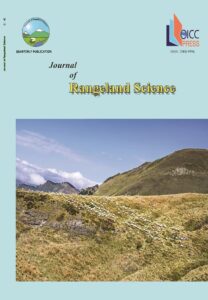Cattle Grazing Impacts on Shoot and Root Characteristics of Urochloa decumbens (Stapf) R. Webster and Axonopus compressus (Sw.) P. Beauv. in Tropical Pastures of Malaysia
Authors
Abstract
This study aimed to assess the responses of Signal grass (Urochloa decumbens) and Carpet grass (Axonopus compressus) shoot and root systems to cattle grazing. Two sites with different grazing strategies were selected in pastures of Selangor state, Malaysia in 2016: one site was dominated by Signal grass and grazed with moderate intensity for long-term (LMG, 2.7 animal unit/ha/yr) and the second site was dominated by Carpet grass and grazed with heavy intensity for short-term (SHG, 5 animal unit/ha/yr). Shoot growth was similarly assessed for both species by measuring herbage mass, plant height, regrowth rate, tiller density and litter biomass four times at the end of the growing periods in both grazed and ungrazed (control) sites. Root samples of species were taken from the center of the individual plants to a depth of 30 cm and analyzed for root length, diameter, surface area, volume and mass using WinRhizo Root Scanner. The relationship between root distribution parameters and soil depth was examined using least square curve fitting. The LMG strategy increased herbage production (g DM/m2), regrowth rate (g DM/d/m2) and tiller density of Signal grass by 19, 26 and 69%, respectively, compared with the ungrazed site (P<0.05). For this grazing strategy, the mean root length (-18%) decreased (P<0.05), but root mass (+46%) increased (P<0.05). In SHG strategy, herbage production and regrowth rate of Carpet grass were unaffected by grazing but tiller density was 147% increased than the ungrazed site. This grazing strategy decreased mean root length by 38%, but increased root diameter and volume of Carpet grass by 22 and 59%, respectively, and had no effect on root mass. It was concluded that short-term heavy grazing had negative impacts on the root characteristics of studied species than long-term moderate grazing. Therefore, long-term moderate grazing by cattle is recommended for the study area.



